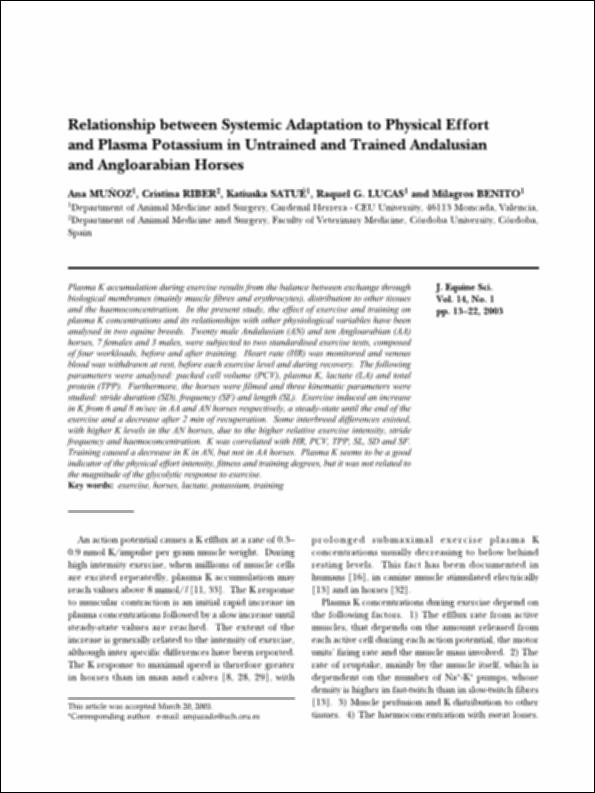Please use this identifier to cite or link to this item:
http://hdl.handle.net/10637/15453Relationship between systemic adaptation to physical effort and plasma potassium in untrained and trained Andalusian and Angloarabian horses
| Title: | Relationship between systemic adaptation to physical effort and plasma potassium in untrained and trained Andalusian and Angloarabian horses |
| Authors : | Muñoz Juzado, Ana Riber Pérez, Cristina Satué Ambrojo, Katiuska Gómez Lucas, Raquel Benito Hernández, Milagros |
| Keywords: | Caballos; Horses; Ejercicio físico; Exercise; Adiestramiento; Training; Marcadores bioquímicos; Biochemical markers |
| Publisher: | Japanese Society of Equine Science |
| Citation: | Muñoz Juzado, A., Riber, C., Satué Ambrojo, K., Gómez Lucas, R. & Benito Hernández, M. (2003). Relationship between systemic adaptation to physical effort and plasma potassium in untrained and trained Andalusian and Angloarabian horses. Journal of Equine Science, vol. 14, i. 1, pp. 13-22. DOI: https://doi.org/10.1294/jes.14.13 |
| Abstract: | Plasma K accumulation during exercise results from the balance between exchange through biological membranes (mainly muscle fibres and erythrocytes), distribution to other tissues and the haemoconcentration. In the present study, the effect of exercise and training on plasma K concentrations and its relationships with other physiological variables have been analysed in two equine breeds. Twenty male Andalusian (AN) and ten Angloarabian (AA) horses, 7 females and 3 males, were subjected to two standardised exercise tests, composed of four workloads, before and after training. Heart rate (HR) was monitored and venous blood was withdrawn at rest, before each exercise level and during recovery. The following parameters were analysed: packed cell volume (PCV), plasma K, lactate (LA) and total protein (TPP). Furthermore, the horses were filmed and three kinematic parameters were studied: stride duration (SD), frequency (SF) and length (SL). Exercise induced an increase in K from 6 and 8 m/sec in AA and AN horses respectively, a steady-state until the end of the exercise and a decrease after 2 min of recuperation. Some interbreed differences existed, with higher K levels in the AN horses, due to the higher relative exercise intensity, stride frequency and haemoconcentration. K was correlated with HR, PCV, TPP, SL, SD and SF. Training caused a decrease in K in AN, but not in AA horses. Plasma K seems to be a good indicator of the physical effort intensity, fitness and training degrees, but it was not related to the magnitude of the glycolytic response to exercise. |
| URI: | http://hdl.handle.net/10637/15453 |
| Rights : | http://creativecommons.org/licenses/by-nc-nd/4.0/deed.es Open Access |
| ISSN: | 1340-3516 1347-7501 (Electrónico) |
| Issue Date: | 2003 |
| Center : | Universidad Cardenal Herrera-CEU |
| Appears in Collections: | Dpto. Medicina y Cirugía Animal |
Items in DSpace are protected by copyright, with all rights reserved, unless otherwise indicated.


